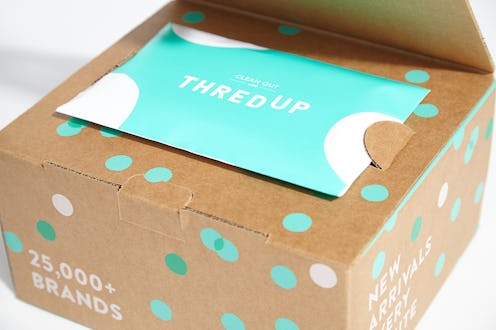
2020 is officially in full swing, which means your resolutions are likely still fresh in your mind. If one of them happened to be focused on helping combat climate change, thredUP's Fashion Footprint Calculator is here to help. The new tool from the online thrifting retailer breaks down how your habits could be contributing to your carbon footprint and outlines the steps you can take to reduce fashion waste and be more sustainable in 2020.
According to thredUP, the calculator is a result of its Fashion Waste Awareness study which polled 1,000 women across the United States regarding their perspective on how much impact the fashion industry has on the environment. The study found 92% of women polled wanted to lower their carbon footprint (the total amount of greenhouse gases produced by an individual) in the fashion space. However, two in three women didn't know where to begin when it come to doing so.
ThredUP Brand Director Erin Wallace spoke with Bustle regarding the findings and the new tool and explained that the results made education a key element of thredUP's mission in 2020. "We found that there was a lot of education that needed to take place to help consumers do better." she says. "Not just when it comes to buying, but also how you care for your clothing, dispose of your clothing, the world around your wardrobe. That’s where the calculator came in."
To create the calculator, thredUP paired with independent environmental research firm Green Story Inc. The firm aggregated peer-reviewed research, analyzed data regarding clothing chain supply cycles, and conducted an independent lifecycle analysis to quantify the carbon footprint of customers everyday actions.
For users, the new tool works like a quiz, asking questions about their everyday habits when it comes to clothing. From the frequency at which they buy used clothes to how they do laundry to clothing disposal, the calculator tallies care and shopping habits then give you a measure of your carbon footprint. Once done, thredUP transitions into providing users with an entire range of ways to decrease their own fashion waste.
Among these suggestions are actions like air drying your clothing instead of using a traditional dryer, sticking to mostly standard shipping for online purchases, and renting for special occasions.
However, thredUP also recognizes the role of brands and companies in making fashion more sustainable. While one of the recommendations to reduce your carbon footprint is to shop more sustainable brands, Wallace tells Bustle that the retailer understands that this can be cost prohibitive for many people. thredUP is here to fill in those gaps.
"We feel really great about the role thredUP serves as a sustainable shopping alternative that’s as affordable as fast fashion, but without the toll on the environment," Wallace tells Bustle. "Buying used instead extends the life of clothes, makes the most of natural resources used to produce them and diverts (often non-biodegradable) textiles from landfills. If everyone in the US bought just one used item instead of new, it would save nearly 6B pounds of carbon emissions — the equivalent of taking half a million cars off the road for one year."
Now that thredUP's Fashion Footprint Calculator has been created and is helping shoppers be more sustainable in 2020, what's next for the brand? Wallace explains that the retailer wants to plug more brands directly into their business model and shift the conversation from simply buying garments to what to do at the end of their lives.
She says, "When we first started, retailers weren’t thinking about the end of life of garments, fashion waste, or circularity — a decade later, consumers are demanding these changes and retailers want to know how to get involved. We want to continue to push traditional brands and retailers to rethink strategies and help them deliver the variety, value and sustainability of resale experiences to their customers."
Whether or not it was your 2020 goal to be more sustainable, ThredUP's Fashion Footprint Calculator will help you reduce fashion waste and learn more about your own carbon footprint. Plus, you can do a little thrift shopping while you're at it.